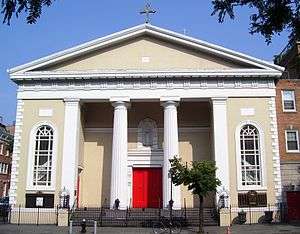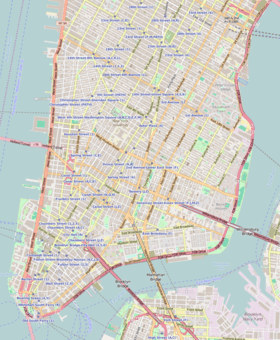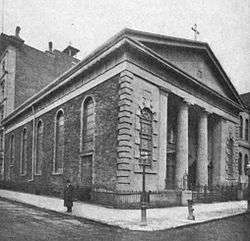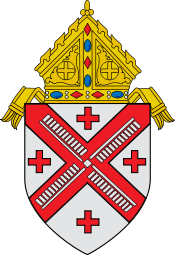Church of St. Joseph in Greenwich Village
| Church of St. Joseph in Greenwich Village | |
|---|---|
 St. Joseph's Church in 2011 | |
 Church of St. Joseph in Greenwich Village  Church of St. Joseph in Greenwich Village | |
| 40°43′57.4″N 74°0′1.8″W / 40.732611°N 74.000500°WCoordinates: 40°43′57.4″N 74°0′1.8″W / 40.732611°N 74.000500°W | |
| Location |
Sixth Avenue, Greenwich Village, New York City |
| Denomination | Catholic Church |
| Religious institute | Order of Preachers |
| Website |
washingtonsquarecatholic |
| History | |
| Status | Parish church |
| Founded | 1829 |
| Architecture | |
| Style | Greek Revival |
| Groundbreaking | June 10, 1833 |
| Administration | |
| Archdiocese | Archdiocese of New York |
The Church of St. Joseph in Greenwich Village is a Roman Catholic parish church located at 365 Avenue of the Americas (Sixth Avenue) at the corner of Washington Place in the Greenwich Village neighborhood of Manhattan, New York City. Built in 1833–34,[1][2] it is the oldest church in New York City specifically built to be a Roman Catholic sanctuary.[1][notes 1]
History
.jpg)
St. Joseph's Parish was founded by Bishop John Dubois in 1829.[3] At the time St. Joseph's Parish began, the population of New York, numbering 203,000, was concentrated in the southern half of Manhattan. The parish boundaries stretched from Canal Street to 20th Street, and from Broadway to the Hudson River. Early church records indicate that St. Joseph's first congregants were predominantly Irish-Americans.
St. Joseph's was the sixth parish to be established in Manhattan, among those still in existence in the Archdiocese of New York. Parishes that preceded it were St. Peter's on Barclay Street (1785), St. Patrick's Old Cathedral on Mulberry Street (1809), St. James on Oliver Street (1827) and Transfiguration on Mott Street (1827).
The cornerstone of the Church was laid on June 10, 1833. The church was designed by John Doran in the Greek Revival style,[1][2][4]>[5] but it has been extensively renovated over the years. Two fires, one in 1855 and the other in 1885, caused extensive damage to the interior. Renovations after the second fire were supervised by Arthur Crooks.[1][2] The interior of the church was restored in 1972. At the time, a fresco of the Transfiguration, after Raphael's original in the Vatican, was discovered under layers of paint and restored. Structural restoration work was performed in 1991 and 1992.
When then-pastor Aldo Tos retired in 2003, the Archdiocese of New York asked the Dominican Order's Province of St Joseph, which was already staffing the nearby Catholic Center at New York University, to assume the responsibility of staffing priests for the parish.[6] The result was a merger of the parish with NYU's Catholic Center in December 2003.[7]
The church today

The Catholic Center provides a wide spectrum of activities, programs, lectures and outreach programs. It is the center of five New York University (NYU) student clubs and for five groups of students and non-students. In addition to its campus ministry and other missions, the parish has been hosting a soup kitchen on Saturdays continuously since the 1980s.[8]
Pastoral staff
- Pastor: Rev. Boniface Endorf, O.P.
- Priests: Rev. John Baptist Hoang, O.P., Rev. Pier Giorgio Dengler, O.P., Rev. Joseph Scordo, O.P.
- Pastors Emeriti: Rev. James Cuddy, O.P., Rev. John P. McGuire, O.P. † (1943–2016),[9] Rev. Aldo J. Tos † (1928-2014),[10] Rev. John D. O'Leary † (1928-2008),[11] Rev. Robert Wilde † 2004,[12] Rev. John P. A. Sullivan † 1971,[13] Rev. Timothy F. Herlihy † 1970,[13] Rev. John P. McCaffrey † 1967[14]
References
Explanatory notes
- ↑ Although the Church of the Transfiguration on Mott Street was built in 1815, it did not become a Catholic Church until 1853. See Church of the Transfiguration Parish history
Citations
- 1 2 3 4 Dunlap, David W. (2004). From Abyssinian to Zion: A Guide to Manhattan's Houses of Worship. New York: Columbia University Press. ISBN 0-231-12543-7. , p.219
- 1 2 3 White, Norval & Willensky, Elliot (2000), AIA Guide to New York City (4th ed.), New York: Three Rivers Press, ISBN 978-0-8129-3107-5 , p.138
- ↑ Remigius Lafort, S.T.D., Censor, The Catholic Church in the United States of America: Undertaken to Celebrate the Golden Jubilee of His Holiness, Pope Pius X. Volume 3: The Province of Baltimore and the Province of New York, Section 1: Comprising the Archdiocese of New York and the Diocese of Brooklyn, Buffalo and Ogdensburg Together with some Supplementary Articles on Religious Communities of Women.. (New York City: The Catholic Editing Company, 1914), p.340.
- ↑ Bahamón, Alejandro and Losantos, Àgata. New York: A Historical Atlas of Architecture (New York: Black Dog and Leventhal Publishers, Inc., 2007), p.99.
- ↑ New York City Landmarks Preservation Commission; Dolkart, Andrew S.; Postal, Matthew A. (2009), Postal, Matthew A., ed., Guide to New York City Landmarks (4th ed.), New York: John Wiley & Sons, ISBN 978-0-470-28963-1 , p.54
- ↑ Wakin, Daniel J. "Catholic Center of N.Y.U. May Move to Nearby Parish" The New York Times (November 18, 2003). Accessed:2008-02-12
- ↑ "Catholic Center Will Stay Put" Archived 2007-06-07 at Archive.is Washington Square News (November 20, 2003). Accessed:2008-02-12
- ↑ Parish website, accessed February 12, 2008.
- ↑
- ↑
- ↑
- ↑
- 1 2 Shelley, Thomas J. (2003). Greenwich Village Catholics. Washington, D.C.: The Catholic University of America Press. p. 187. ISBN 0-8132-1349-5.
- ↑ Shelley, Thomas J. (2003). Greenwich Village Catholics. Washington, D.C.: The Catholic University of America Press. p. 182. ISBN 0-8132-1349-5.
External links
| Wikimedia Commons has media related to Church of St. Joseph in Greenwich Village. |
